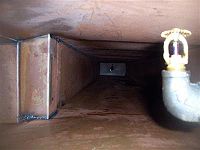
Kitchen exhaust cleaning
Encyclopedia
Kitchen exhaust cleaning (often referred to as "hood cleaning") is the process of removing grease that has accumulated inside the ducts
, hoods, fans and vents of exhaust systems of commercial kitchens. Left uncleaned, kitchen exhaust systems eventually accumulate enough grease to become extreme fire hazards.
Exhaust systems must be inspected regularly, at intervals consistent with usage, to determine whether or not cleaning needed before a dangerous amount of grease has accumulated.
or with a chemical foamer.
Once the chemicals are applied, they are allowed to dwell on the surface of the grease for a period of time, before being washed off of the surface with hot water. In extreme situations, where grease buildup is too heavy for a chemical application and a rinse, scrapers may be used to remove excess buildup from the contaminated surfaces, before chemicals are applied.
Standard 96, Standard for Ventilation Control and Fire Protection of Commercial Cooking Operations
and require compliance to it by cleaners and operators of commercial kitchens.
 Several associations have been formed to educate kitchen exhaust cleaners on the provisions of NFPA 96 standard and on the best standards and practices for kitchen exhaust cleaning. Among these are:
Several associations have been formed to educate kitchen exhaust cleaners on the provisions of NFPA 96 standard and on the best standards and practices for kitchen exhaust cleaning. Among these are:
Each organization has its own philosophies, but they all have the goal of improving the kitchen exhaust cleaning industry.
Grease duct
A grease duct is a duct that is specifically designed to vent grease-laden vapors from commercial cooking equipment such as stoves, pizza ovens, deep fryers and woks to the outside of a building or mobile food preparation trailer. Grease ducts are regulated both in terms of their construction and...
, hoods, fans and vents of exhaust systems of commercial kitchens. Left uncleaned, kitchen exhaust systems eventually accumulate enough grease to become extreme fire hazards.
Exhaust systems must be inspected regularly, at intervals consistent with usage, to determine whether or not cleaning needed before a dangerous amount of grease has accumulated.
Cleaning processes
The complete Kitchen exhaust systems (top to bottom) are first scraped clean and then washed clean with food safe caustic chemicals and hot water pressure-washing where possible to safely collect dirty water by-product.Caustic chemicals
Caustic chemicals can be applied to break down the grease. After that, hot water can be used to rinse away the residue. Chemicals are generally applied with either a garden type sprayer, downstream injection through a pressure washerPressure washer
A pressure washer is a high pressure mechanical sprayer that can be used to remove loose paint, mold, grime, dust, mud, and dirt from surfaces and objects such as buildings, vehicles, and concrete road surfaces. The volume of a pressure washer is expressed in Gallons Per Minute, which is designed...
or with a chemical foamer.
Once the chemicals are applied, they are allowed to dwell on the surface of the grease for a period of time, before being washed off of the surface with hot water. In extreme situations, where grease buildup is too heavy for a chemical application and a rinse, scrapers may be used to remove excess buildup from the contaminated surfaces, before chemicals are applied.
Hot water pressure-washing
Machines can be used that both boil water and then apply this water under pressures up to 2000PSI. In a common method of preparation, heavy-duty tarps are first clipped to the hoods and then angled into plastic garbage cans to catch the run-off. As the cans are filled the contents are disposed of successively. The grease should be removed rather than just emptied into the local drains to avoid clogging issues.Finishing
Cleaners often polish hoods for easier cleaning and improved appearance. Cleaners apply a sticker to the hood of each cleaned exhaust system to enable the Authority Having Jurisdiction as well as insurance adjusters to check for compliance with the local fire code.Regulation
Many jurisdictions have adopted this nations minimum available standard, National Fire Protection AssociationNational Fire Protection Association
The National Fire Protection Association is a United States trade association that creates and maintains private, copywrited, standards and codes for usage and adoption by local governments...
Standard 96, Standard for Ventilation Control and Fire Protection of Commercial Cooking Operations
and require compliance to it by cleaners and operators of commercial kitchens.
Industry education

- International Kitchen Exhaust Cleaning Association
- Power Washers of North America
- Certified Hood and Duct Cleaners Association.
Each organization has its own philosophies, but they all have the goal of improving the kitchen exhaust cleaning industry.

